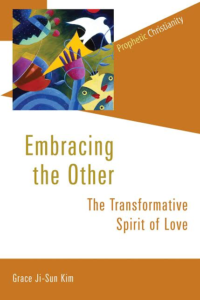Margins as Places of Despair and Hope: Reflections on Embracing the Other: The Transformative Spirit of Love (Eerdmans, 2015) by Grace Ji-Sun Kim by Edwin David Aponte
Asian immigrants experience a betwixt-and-between predicament, which serves as resource for a creative rethinking of cultural traditions —both native and foreign. Being in-between is being neither this nor that but also being both this and that.
—Grace Ji-Sun Kim, Embracing the Other, 55.
Being a second-generation Puerto Rican Latino from New England often I still find myself relegated to the margins of various contexts, of being “neither this nor that.” This is the case even despite my education, employment, and class location because of the reality of racism and White supremacy in the United States. And perhaps that is one of the reasons I resonated with Grace Ji-Sun Kim’s observation that within the in-between place of the margins there are creative resources for change.
Grace Ji-Sun Kim provides us with an exercise in understanding the human systems that create and sustain all types of marginalization including oppression, sexism, racism, poverty, and Christianity’s complicity with White supremacy. From the creative spaces of the margins Kim provides an angle from which to reimagine Christian theology and how it might better help the most marginalized. And when the marginalized are embraced, there is the potential for all to be embraced by God’s transforming love. This is not solely an academic exercise, but an activist call to truly embrace others, combat oppressions, and reject racism and sexism. Indeed, the whole book is an exploration of the nature of Christian types of embracing. One of the things Kim does on this journey exploring the margins is embrace herself as an Asian American woman in North America. And from the particularity of that position Kim embraces the notion that “The Spirit is the heart and soul of Christian theology” (p. 4). With that starting point everything is placed into a different perspective, whether one is located at the centers or the margins of society.
 Kim offers her own theological insight about the Spirit of God, grounded in her understanding of Trinitarian theology. As an alternative to dominant understandings of God flowing Eurocentric theological constructions, and drawing on Asian perspectives she elaborates an understanding of Spirit-Chi as “the hybrid life-giving Spirit of God” (p. 9). This understanding of Spirit-Chi opens a path for hopeful, holistic, ways for peace and reconciliation in personal and communal relationships, particularly in a North American context of rapid, multiple, unsettling changes in every area of society and church. Embracing the Asian concept of Spirit-Chi is an avenue for mercy, reconciliation, liberation, and social justice and a way to choose to combat injustice, sexism, racism, and separation while choosing to embrace the other. Embracing the Spirit-Chi of God enables all of us to embark on path to connection, shared love, healing, and thereby being empowered to love others in the hope of Spirit-Chi of God, so that in even in the midst of life on societal margins there is unexpected blessing and empowerment, for as Kim reminds “we come to meet the God who also exists on the margins. This is the Spirit God who has always been part of our history, culture, religion, and ancestral heritage” (p. 166).
Kim offers her own theological insight about the Spirit of God, grounded in her understanding of Trinitarian theology. As an alternative to dominant understandings of God flowing Eurocentric theological constructions, and drawing on Asian perspectives she elaborates an understanding of Spirit-Chi as “the hybrid life-giving Spirit of God” (p. 9). This understanding of Spirit-Chi opens a path for hopeful, holistic, ways for peace and reconciliation in personal and communal relationships, particularly in a North American context of rapid, multiple, unsettling changes in every area of society and church. Embracing the Asian concept of Spirit-Chi is an avenue for mercy, reconciliation, liberation, and social justice and a way to choose to combat injustice, sexism, racism, and separation while choosing to embrace the other. Embracing the Spirit-Chi of God enables all of us to embark on path to connection, shared love, healing, and thereby being empowered to love others in the hope of Spirit-Chi of God, so that in even in the midst of life on societal margins there is unexpected blessing and empowerment, for as Kim reminds “we come to meet the God who also exists on the margins. This is the Spirit God who has always been part of our history, culture, religion, and ancestral heritage” (p. 166).
Kim takes a look at a Biblical group on the margins, the foreign women discussed in Ezra and Nehemiah and how such women were scapegoats, marginalized, and eventually expelled from the community, relating their story to the experiences of marginalized women of color, especially Asian American women. I found this very helpful, but at the same time I wonder how the conversation might be enriched through engagement with the mimetic theory of René Girard and, especially as Michael Hardin interprets it in his peace-building approach. Briefly stated Girard’s mimetic theory asserts that humans imitate each other, leading to jealousy, enmity, conflict, and violence. This in turn leads to resolution via designating someone a scapegoat for the perceived problem. I think that Kim would find welcome dialogue partners with those who challenge the Church to think of alternatives to the type of marginalization that employs a scapegoat theology.
Kim investigates the notion of hybridity, which also affirms that in the marginalization of life that is hybridity there also is found a rich complexity of concurrent multiple identities with their unique resources for life for “construction of a more just and sustainable world.” (p. 106). The lens of hybridity also is helpful in considering the marginalized foreign women in Ezra-Nehemiah. How do we account for such stories making it into the canon of Scripture? Especially since as Kim discusses two other stories in the canon, those of Rahab and Ruth, two important foreign women in salvation history, the latter in the genealogical line of David and Jesus. The fact that these stories of marginalized women also are canonical emphasizes the importance of Kim’s discussion on hybridity and the gift it can be in embracing the other. Moreover, it also points to the complex hybridity of the canon, and how that is another multidimensional issue for us to consider. How is the transformative Spirit-Chi of love working through all this hybridity, which from one perspective may seem to be in contradiction, if not in opposition with one another? This is the case not only in the hybridity of the canon, but also the hybridity in our own personhood, in the communities of which we are a part, and finally of the challenges we face when we seek to build new communities that cross boundaries that go beyond recognized margins.
In lifting up the power of the transformative Spirit of love Kim states “Approaching God through spirituality is a way for people to come to know God by experiencing God rather than through exegesis and theological discussion alone.” (p. 109). I was struck that I don’t know of any Pentecostal or Charismatic who would disagree with that statement. This highlights another type of hybridity and marginality worthy of exploration. Spirituality and understanding of Spirit invites more conversation with Pentecostal/Charismatic theologians and practitioners. It might be that there is more in common, and a greater foundation for collaboration. This is especially the case as we consider the Korean concept of jeong as “sticky” love expressed through interconnection. Perhaps it is through the Spirit-Chi working out jeong in the margins that the hopeful power of transforming love will spread to all.
Edwin David Aponte is Executive Director of the Louisville Institute. Funded by the Lilly Endowment, Inc., the Louisville Institute seeks to enrich the religious life of North American Christians and to encourage the strengthening of their institutions by bringing together those who lead religious institutions with those who study them, so that the work of each might inform and enhance the work of the other.
Aponte graduated from Gordon College (B.A.), Gordon-Conwell Theological Seminary (M.A.T.S.), and Temple University (M.A., Ph.D.). As a cultural historian Aponte explores faith, spirituality and culture, especially the intersections of race, ethnicity, and religion. His various writings include ¡Santo! Varieties of Latino/a Spirituality (Orbis Books, 2012).

